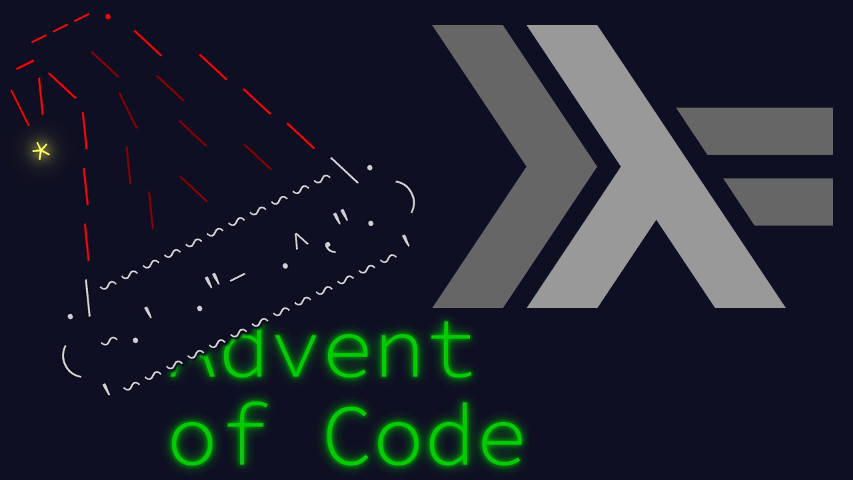A shortest path problem on a 2D grid. Color me surprised. Today’s problem, “Race Condition”, isn’t anything drastically new as far as Advent of Code goes. No matter, we’ll solve it nonetheless. Starting with a few imports, since this is as literate Haskell as ever.
import Control.Arrow ((&&&))
import Data.Array (Array,listArray,bounds,(!),indices,inRange,range)
import Data.Array.ST (runSTArray,newArray,readArray,writeArray)
import Data.List (find)
import Linear.V2 (V2(V2))
type V = V2 IntThe puzzle input is a 2D grid. I’ve stopped counting how many times
my parse function was this for the year.
parse :: String -> Array V Char
parse s = listArray (V2 1 1,V2 h w) (concat raw) where
raw = lines s
h = length raw
w = length (head raw)So, we want to count 100-cheats. What’s an N-cheat? It’s a singularity in the map where skipping across a wall once would result in a total race time that’s better than the normal race time by N − 2. −2 because it still does take two time units to walk across the wall.
solve :: [V] -> Array V Char -> Int
solve jumps g =The easiest way I know to check for cheats is to know, for every position on the grid, how far it is from the goal. This way, we can identify good cheats by simply comparing distances-to-goal of both cheat start and end point.
Let’s first locate the endpoint.
let
Just goalPos = find ((== 'E') . (g!)) (indices g)We can then construct those distances to goal by simple BFS.
dists = runSTArray (newArray (bounds g) maxBound >>= bfs [(goalPos,0)]) bfs [] a = pure a
bfs ((p,d):q) a = do
prev <- readArray a p
enqueue <- if prev < maxBound
then pure id
else do
writeArray a p d
pure $ flip (++)
$ map (,d+1)
$ filter ((/= '#') . (g!))
$ filter (inRange (bounds g))
$ map (p +) dirs
bfs (enqueue q) aThe precise formula to evaluate a cheat is the gain in distance minus the time consumed by the cheat itself. It’s always 2 in part 1, but let’s keep it generic. Of course, cheats are only defined from actual racetrack positions, in other words, any place not a wall.
eval p d
| g!p == '#' = minBound
| p' <- p+d =
if | not (inRange (bounds g) p') -> minBound
| g!p' == '#' -> minBound
| otherwise -> dists!p - dists!p' - manhattan (p'-p)We’ll call that with an externally-provided list of jump vectors, so the bounds checks are performed inside.
The list of cheat [values] can then be defined on the cartesian product of positions by possible jumps.
cheats = eval <$> indices g <*> jumpsWe’ll have all of the invalids in there as minBound.
They aren’t exactly a problem as we’re filtering for the top anyway.
in length (filter (>= 100) cheats)The valid jumps take us from a race position to any other valid race position 2 units in any direction, provided the destination is also a valid race position, and the intermediate position is a wall.
jumps1 :: [V]
jumps1 = map (2 *) dirsSorry, no, that was too complicated. If the destination isn’t a valid
race position, its distance to the goal as computed by our BFS will
remain maxBound, so it doesn’t hold a good chance of
standing out, and there’s no need to check for that.
Similarly, it the intermediate position isn’t a wall, well, cheating doesn’t make a difference from not cheating. In a very literal meaning: the gain in skipping collision detection for 2 picoseconds will be zero, so those cheats are worth exactly that. We could debate for a long time whether or not that makes them valid cheats, but for all practical purposes, they’re not going to pass the N-cheat test and hence be an issue worthy of further consideration.
Part 2 extends the cheat time. So we extend the cheat range.
jumps2 :: [V]
jumps2 = let r = 20 in
filter ((<= r) . manhattan) (range (V2 (-r) (-r),V2 r r))That’s the gist of it. Let’s add a support function and a useful constant list.
manhattan :: V -> Int
manhattan = sum . abs
dirs :: [V]
dirs = [V2 (-1) 0,V2 0 1,V2 1 0,V2 0 (-1)]And a wrapper.
main :: IO ()
main = interact $ show . (solve jumps1 &&& solve jumps2) . parseI think that’s it.
See you tomorrow!



